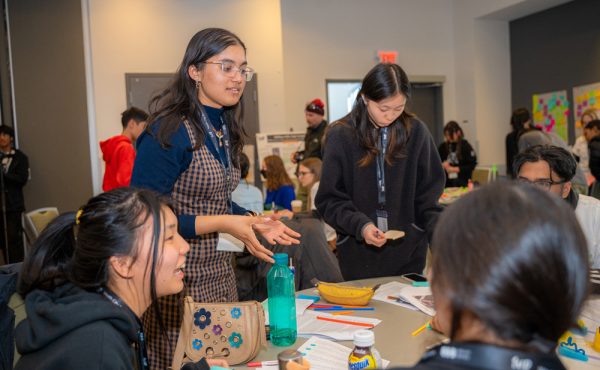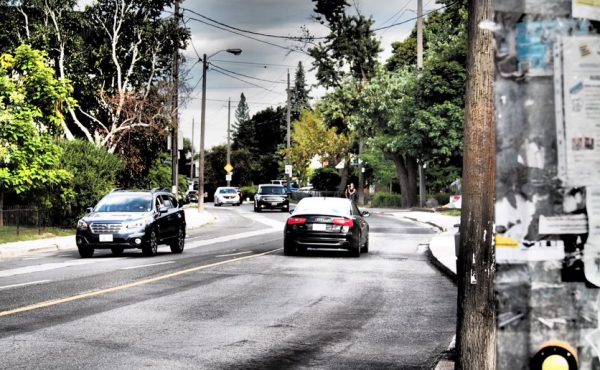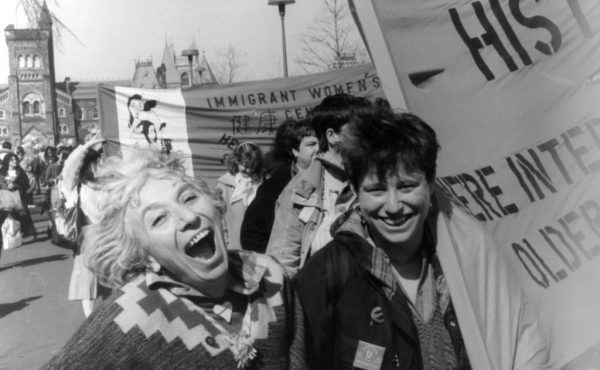
EDITOR’S NOTE: Josh Fullan, who teaches English and Civics at the University of Toronto Schools (a private high school affiliated with the University of Toronto), organized the Jane’s Walk School Edition featured in the “Walking” column in the Summer-Fall 2009 issue of Spacing. He sent us this follow-up guest column with some further thoughts about what he and his students learned from the project.
On a sunny afternoon last spring, as part of a series of Jane’s Walks led by grade 7’s at the University of Toronto Schools (UTS), some of the kids I teach English to presented in front of a small audience just outside of Robarts Library. The students chose to animate a topic that had bugged them during their wanderings around campus earlier in the month, when twice they had found a conspicuous build up of litter on the pathways and lawns to the west of the giant library. Tossed bottles, loose paper, and fast food wrappers cluttered an otherwise inviting play or hang-out space. As the students addressed their audience, a boy stood on a bench and held up an empty Coke can as evidence. For the kids, aged 12 and 13, the solution to the litter problem was simple: more garbage cans please.
The walk was later featured in a Spacing article seen by a staffer at City Councillor Adam Vaughan’s office, who promptly sent a copy to the University of Toronto and asked them to put more garbage cans in the neglected area. When I told my students about how their observation had sparked this bit of political action, their reaction was again straightforward and enthusiastic: “That’s so cool!”
It is a pretty cool story, but it’s more than that. It’s also an example of the too rare phenomenon of youth engagement and involvement in the process of community planning and improvement.

The school I teach at is located right at the corner of a major downtown intersection, and for all its many virtues, UTS is guilty of a trend described in school demographics as student centralization. In practical terms, this means that we draw our student body from all over the GTA, and that many of them travel, mostly by subway and by car, considerable distances to join the school starting in grade 7. And like a lot of kids at schools around the GTA, few of them walk, ride a bike, or skateboard through the community to get to school. Commuter parents have begotten commuter kids. Partly as a result of this centralization, many of our students don’t know the school neigbhourhood at all. They know the variety store across the street where the owners are nice to them, and a couple of other places to grab cheap food. In a mapping exercise we do with the students in preparation for the walks, most of them identify only a handful of places they use in the neighbourhood.
So when we first got out walking last year to plan and research Jane’s Walks, and again this year when I started to plan walks with a different group of older kids, most of the students were exploring the school’s urban community for the first time. It didn’t take them long, however, to figure out that much of city life is not that kid-friendly. A lot of it, in fact, is cruel and discriminatory to them. The students weren’t allowed into a park directly behind the school because they were too old. Another park just north of the school seemed to always be frozen in a state of mid-repair and was too rundown to play or hang out in. Kids also talked about not feeling welcome in many local businesses, either because they were perceived as a nuisance or because they didn’t have any money to spend. And still others were drawn to spaces that were either forbidden or dangerous to them: a group of boys wanted to join some other kids running around on one of the private rooftop playgrounds in the neighbourhood; another handful had to be restrained from darting across busy Spadina Avenue to play on the undulating concrete median pictured below, which they called “The Wavy Place”:

The kids also struggled with many of the conveniences and shortcuts adults take for granted when walking a city. They had trouble traversing a wide intersection at a dying traffic light. They couldn’t figure out how to navigate a nearby construction site as they tried to get to Philosopher’s Walk, and then had to circle the entire block to reach their destination. Jaywalking, knifing through crowds, stepping off the curb onto the street when needed, claiming their space on the sidewalk—all of these things were a challenge for them. The reactions of passersby to the approach of a group of kids on a busy sidewalk ranged from mild disappointment to outright hostility. Is it any wonder fewer and fewer kids get out to autonomously explore their neigbhourhoods? Or that they exhibit low levels of community and urban literacy? Until we start to count and consider their voices, while at the same time finding ways to get them out more in their school and home communities, it really is the hard-knock city life for them.
Schools are an obvious context for starting the process of building community participation and awareness in youth, with programs like Jane’s Walks School Edition, which has led to additional related programs at UTS. This year a few students and teachers at our school started a fledgling Urban Studies Group called Jane’s Club, which meets after school for things like Graffiti Tours and a visit from our local city councillor to discuss changes in the immediate school neighbourhood.
Children and youth make up a sizable chunk of the age demographics of this city, yet their needs and opinions are seldom considered in the planning and decision-making processes. According to the 2006 City of Toronto Census (PDF), school age children (5-14) and youth (15-24) together account for almost one quarter of the city’s population, with many of them concentrated in dense downtown neighbourhoods [hyperlink1]. Worldwide, children account for one third of city populations, a UNICEF figure detailed in a recent Vanier Institute of the Family study by Juan Torres entitled Children & Cities: Planning to Grow Together (PDF). Yet this youth demographic, as the study goes on to point out at length, is sorely undervalued and underrepresented in the planning and decision-making processes that affect it.




5 comments
This ‘youthShadow’ effect where the instructions of Victorian England seep into the culture of 21st century northAmerica and, indeed around the world; children (of all ages)are “seen and not heard!”
And why is that? Because we are too preoccupied in our own ‘magnificence’ and all the marvelous advances in civilization, fairness, egalitarianism, and, oh yes ‘smartPhones’, that we have been responsible for since we were their age.
[and perhaps a little bit because “they can’t vote!”]
“Is it any wonder fewer and fewer kids get out to autonomously explore their neigbhourhoods?”
I thought it was because their parents are worried that they will be abducted by pedophiles, or something.
Grade 7 kids motivated to clean up litter on and around campus, this sounds like heaven.
Hope the kids at Monarch Park CI read this, there is a lot of litter in this area. I pick up some walking to the store but I cannot bend down as well as I once did.
Good luck in your work Teacher Fullan
Well, to be fair, at that age at UTS, most kids are barely keeping up with the craziness and onslaught of homework that is assigned to them, let alone have the time to explore the neighbourhood around them.
I was once one of those UTS commuter kids, coming down from Markham (taking 1.5 hrs one-way) so if I finished school at 3:40PM, the earliest I could get home was around 5PM, which when you combine with all the homework, extracurricular work and what not one has to do, was pretty late already. The only real time to explore the Annex or the St. George campus was during lunch time, but I think most kids were more interested in eating lunch in the Commons or hanging out by G’s than going down to the Bloor Cinema or hanging by the Green Room.
Of course, as one gets older and learns how to manage time more efficiently, interests change and the surrounding areas begin to be explored. By grades 9 or 10, people started looking outside of the immediate confines of St. George to Spadina Station. Good on you for sparking this interest in the students though!
I think even the most hardened politician would soften to the political voice of children. Good on you for helping these students find their voices. Perhaps projects like this will help engender a political generation this city, and country, so sorely needs. Goodbye, Mr. Chips. Hello, Mr. Fullan.